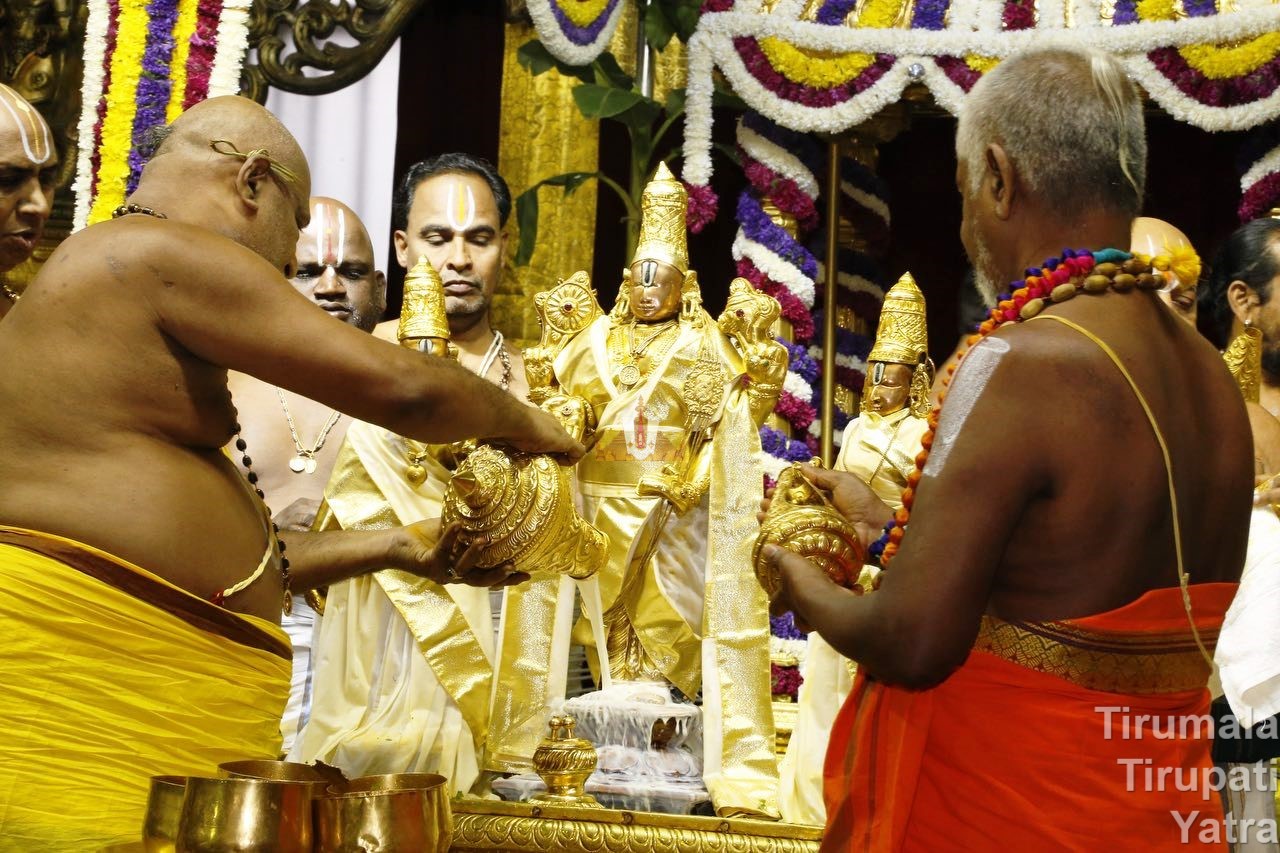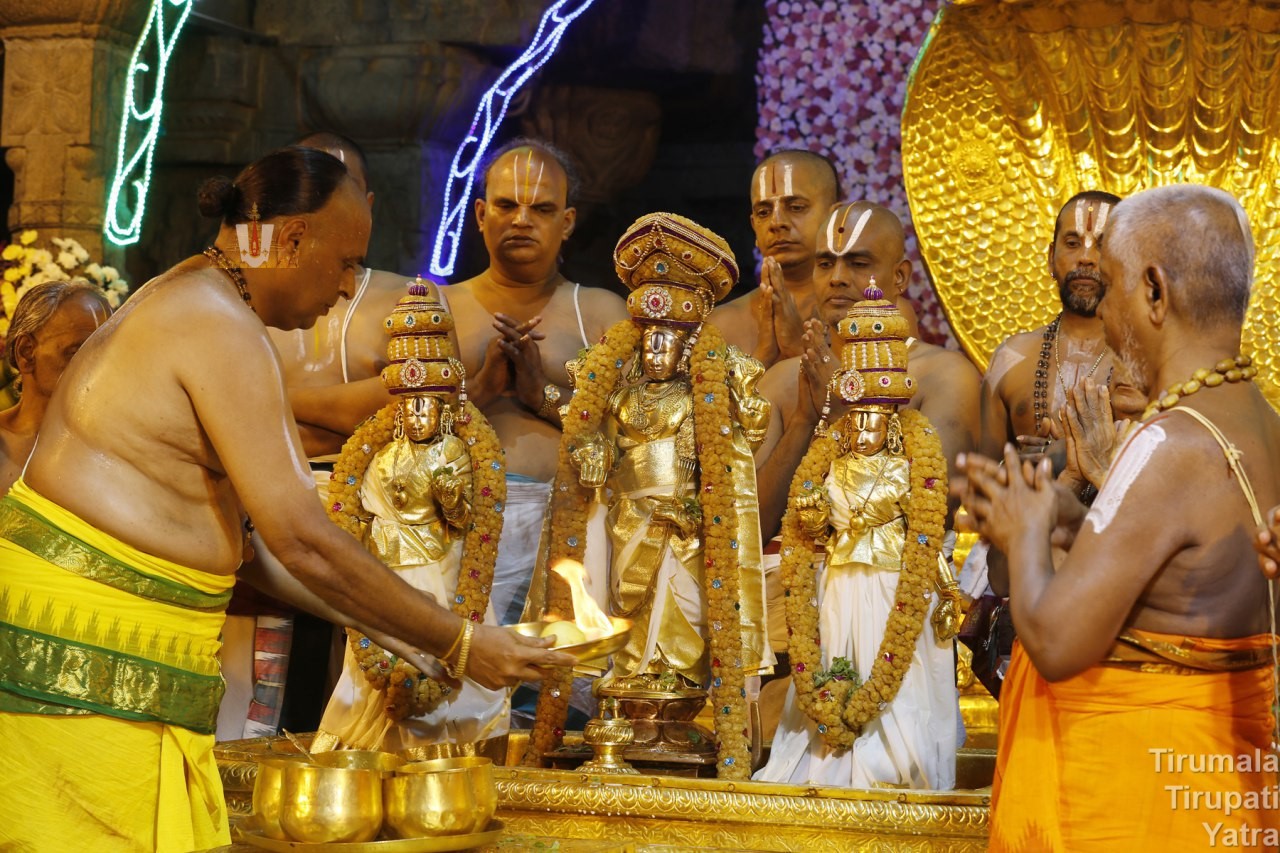Table of Contents
ToggleBrahmotsavams
Once in a year, the Brahmotsavams are being celebrated to Lord Venkateswara. In the procession, the Lord takes a majestically reclined posture on the various ‘vahanams’ (this page is dedicated to Garuda Seva / Garuda Vahanam).
‘Padakavita Pitamaha’ Annamacharya eulogizes Lord Venkateswara as ‘Tiruveedullo merese Devadevudu,’ and ‘Naanaadikkula Narulella vaanalalone vatturu.’ Lord Brahma initiates the ‘utsavams’ following the command of Lord Venkateswara.
So these ‘utsavs’ are called ‘Salakatla (Annual) Brahmotsavams.’ These ‘utsavams’ will be celebrated for a period of ten days.
Garuda Seva / Garuda Vahanam
In this Garudotsava, the Lord’s consorts do not take part.
The festival of Garuda which is celebrated on the night of the fifth day takes a prime place in the nine-day Brahmotsavas of Tirumala.
The blend of Vishnu and Garuda manifests itself as the form and head of Vedas.
The Vedas come under a quintuple division, the Rigveda, the Krishna Yajurveda, the Sukla Yajurveda, the Samaveda, and the Atharvaveda.
Hence, during the nine-day Brahmotsavas, the service of Garuda is celebrated on the fifth day.
In the Garuda Panchakshari Mantra [Om Pakshi Swaha] there are only five letters. So the festival of Garuda, which is hailed as ‘Panchavarna Rahasya’ is being performed on the fifth day.
It is a known fact that on the night of service to Garuda, Tirumala is crowded with lakhs of devotees, like particles of sand on a beach, from all the nooks and corners of the country.
Slokam
Kapilaksham Garutmantam suvarna sadrusa prabham
Dirghabahum brihatskandham vande naganga bhushanam
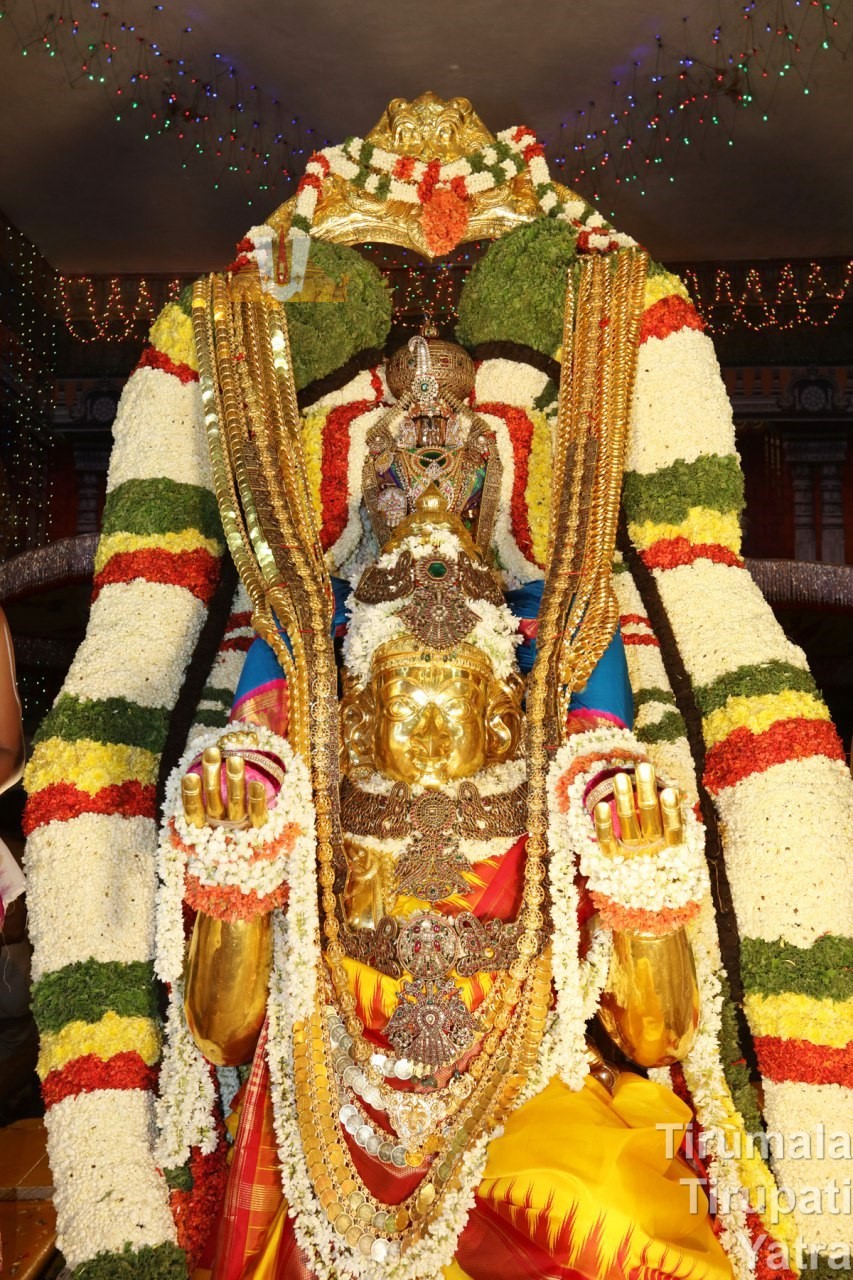
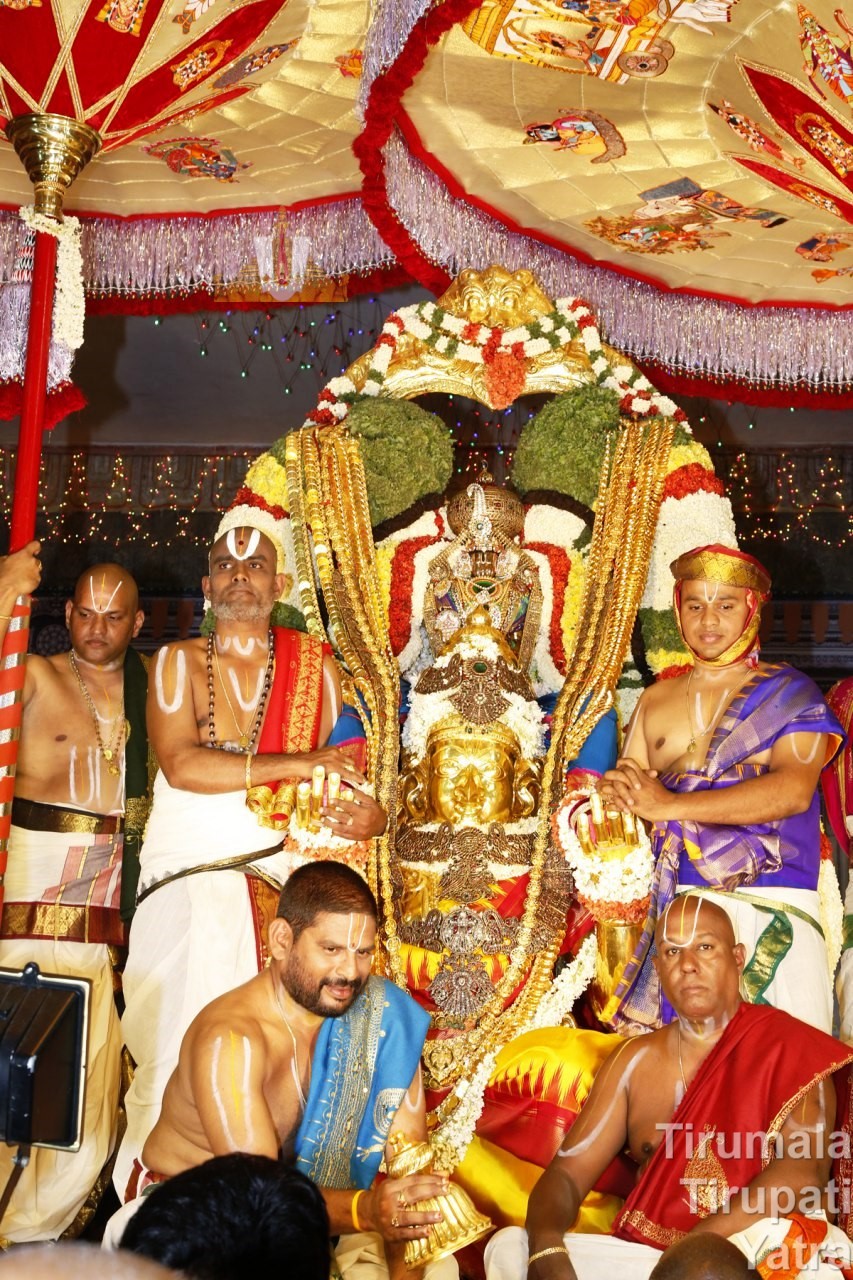
One cannot describe the beauty of Garuda Seva, Devotees have to see on their own
Garudadri is one among the renowned names of the seven hills. The hill bears the shape of Garuda, “Sriseshasaila, Garudachala, Venkatadri, Narayanadri, Vrishabhadri, Vrushadrimukhyam”.
Krite vrishadrim vakshyanti tretayam Garudachalam
Dwapare seshasailam cha venkatadrim kalau yuge.
Garuda brought ‘Venkata’ a sporting hill in Vaikuntha to the earth as ordered by God Varaha Vishnu, and installed it to the north of Suvarnamukhi.
Garuda is the car of God Vishnu. He is also his flag. So the Brahmotsavas start with the hoisting of the flag.
They come to an end with the descent of the flag. Garuda, standing on the flag post, invites all the three crore gods to the Lord’s Brahmotsavas.
Malayappaswamy is bedecked with special ornaments like Makarakanti (an ornament that is made to adorn the back of a woman with the head of a crocodile imprinted on it), Lakshmi haram and Venkateswara Sahasranamamala among others which are normally worn by the prime statue of Venkateswara.
Malayappaswamy is decorated with garlands with which Godadevi was decorated earlier and brought from Srivilli Puttur of Tamilnadu to Tirumala.
Garlands removed from Andal Tayar are used for decorating Garuda Seva
The tradition of decorating the Lord on the day of Garudotsava, with garlands removed after decoration to Andal Tayar (Godadevi) from her birthplace Srivilliputtur temple, was in vogue from the time of Krishnadevaraya.
Malayappaswamy goes on the holy streets of Tirumala and blesses devotees galore with his boon-giving hands:
Godasamarpita suvasitapushpamalam
Lakshmi haramanibhushita sahasra namnam
Malam vidharya Garudopari sannivishtah
SriVenkatadrinilayo jayathi prasannah
The Lord of Venkatadri thrives in joy, riding Garuda and wearing the garland worn by Godadevi and Lakshmihara, and Sahasranamamala.
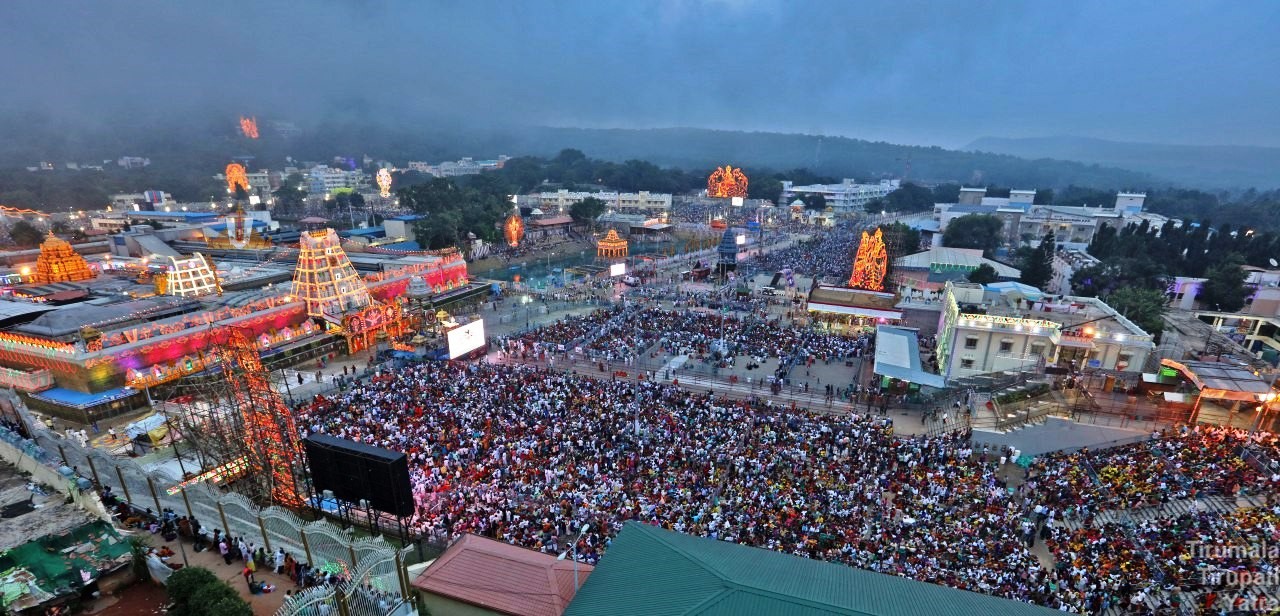
Umbrellas from Chennai to Tirumala on Foot
Every year, on the day of the festival, of Garuda Seva, “Tirupati umbrella charities” in Chennai [now Hindu Dharmarthasamiti] devoutly offer nine umbrellas to the Lord – Six big ones and three smaller ones – prepared afresh, worshipped and brought from Chennai in a procession on foot.
Along with these umbrellas, the landlords, offer in a bamboo tray, “Srivari pulangi kapai”, dhothi, Lakshmidevi’s ‘pavada’s (the pieces of cloth used to cover the girdle), the large umbrellas for Padmavati devi of Tiruchanoor,’ kapali’, turmeric, kunkum, sandal etc. as gifts (‘Saare’) to the lord.
The officials of the endowment receive the umbrellas and the boxes with gifts from landlords, after duly honoring them.
Thus the festival of Garuda in honor of Lord Venkateswara is celebrated with special and costly ornaments, new silk garments, and new umbrellas with splendor and pomp, a delight to the eye.
Feet like red lotuses resting in the hands of Garuda
Annamayya describes the pomp and the bustle of the festival in more ways than one and the marvelous power of the Lord:
As you ride Garuda, in thunderous sound
The directions are torn apart.
In this festival, Malayappa Swamy sits alone in dignity with his feet like red lotuses, resting his feet in the hands of Garuda that look like packs of nascent leaves.
This shows that the feet of the Lord are the sole refuge of the devotees.
Snapana Tirumanjanam
Every year during Brahmotsavam, a special Snapana Tirumanjanam will be held at Ranganayakula Mandapam in Tirumala.
The processional deities of Sri Malayappa Swami along with Goddesses Sridevi and Bhudevi will be seated on a special platform and were offered the sacred bath with aromatic ingredients.
As part of this, some special decorations to match the occasion will stand as a special attraction every year. Apart from decorating the stage, with colourful flowers, orchids, fruits, creepers, the garlands that were offered to Sri Malayappa Swami remained unique.
The garlands made of Finger Millet (Ragi Mala), Green Pavitras and Coral malas which have also made their maiden way in Snapana Tirumanjanam in addition to Cardomom, Cuscus, Grapes, Tulasi garlands etc.
It is not only the Desi cereals, fruits, flowers, spices that sanctify their lives in the divine service, but also the apples, Grapes, Pears, Mangoes and Cherries that sailed all their way travelling thousands of kilometres from their homelands to bliss their lives in the service of Universal Lord, Sri Venkateswara.
